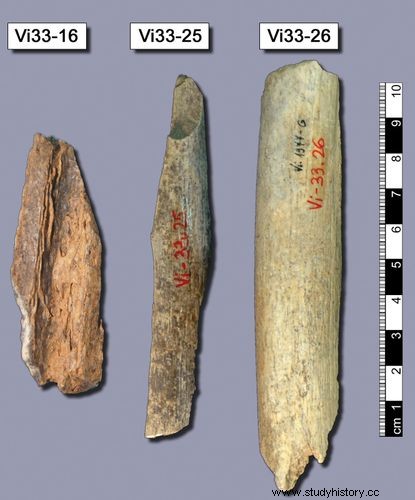Vindija , site of paleoanthropological excavations in the Croatian Region Hrvatsko Zagorje , known for There were in the 1970s Neanderthal found; Neanderthal DNA has since been successfully isolated from a few samples. The Vindija Cave also contains a long, rich sequence of artifacts from the Paleolithic, from more than 200,000 years ago to about 10,000 years ago rich . The late age and properties of some of the fossils and related artefacts found at Vindija suggest that Neanderthals ( Homo neanderthalensis ) and early modern humans ( H. sapiens ) coexisted elsewhere in Europe for a while.

The oldest fossils from the cave date to around 40,000 years ago and consist of immature and adult pieces of braincase, Frown, upper and lower jaw, isolated teeth and limb bones. They exhibit a number of typical Neanderthal cranial and dental features, as well as some aspects of the limb bones. Despite similar body sizes to other Neanderthals, these individuals have rather small faces. Also, the eyebrows are relatively thin and less prominent than those of other Neanderthals, and the jaws are small and pointed beginning chin holes and shoulder joints closely resemble those of modern humans. These clues point to a reduction in Neanderthal traits in these relatively late Central European Neanderthals, thus reducing their contrast with early modern humans in the region.
The more recent fossils show a similar reduction of the forehead and lower jaw, while some typical Neanderthal features of the face, teeth and limbs are preserved. Like Neanderthal remains in Saint-Césaire in France, however, they are associated with references to a technology usually associated with early modern people. Moreover, these remains have been directly dated to around 34,000 years, making them the youngest known Neanderthals. Your age also means , that they simultaneously with early modern people known from neighboring areas of Eastern Europe. This suggests that early modern humans, when they spread west across Europe about 36,000 years ago, did not quickly drive the Neanderthals to extinction, but several millennia into neighboring regions lived. Some scholars suggest that the cultural differences between the two groups must have been modest and that they had ample opportunity to exchange mates where they came into contact. Others claim that the groups do not cross.
